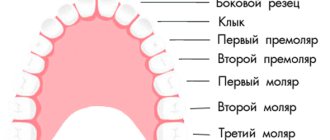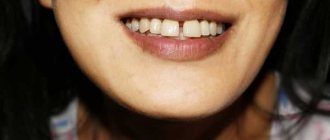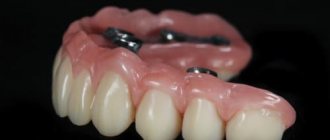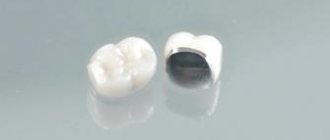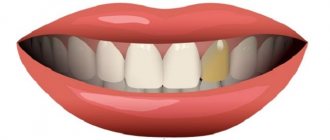Halitosis affects about a quarter of the US population. It is interesting to note that during my lecture at the Hinman Dental Conference on halizote, I asked the audience who in the audience thought they had bad breath. About 80% of those present raised their hands. I was shocked because these were people working in dental clinics!
Now you can imagine why selling consumer products designed to combat bad breath is a four billion dollar a year business. There is no doubt that dentists should include the treatment of bad breath in their treatment plans and in the work of our clinics in general.
Thank God that scientists and researchers are studying such an urgent problem as halitosis. It is known that more than 90% of the sources of unpleasant odor are associated with the oral cavity and are the result of the decomposition of protein residues by anaerobic bacteria, which leads to the formation of volatile sulfur compounds. Such volatile compounds are usually methyl mercaptan and sulfide hydride, which have the smell of “rotten eggs” or hydrogen sulfide. Typically, patients can pinpoint the location in the mouth where they think this “aroma” is coming from, because these gaseous compounds have a very pungent odor. I have had many patients say, “Oh, that smell is coming from between my central incisors,” or, “I get a nasty taste from the spaces between my upper molars on both sides.” In some cases, the sources of bad breath may be in the nose, throat or stomach. Unfortunately, consideration of all possible causes of unpleasant odor is beyond the scope of this article. Suffice it to say that in most cases the problem is related to the oral cavity, and therefore we, dentists, are the very specialists who are actually supposed to cure bad breath.
Your nose is an excellent smell detector and is by far the most advanced odor analyzing device on the planet. Your nose can smell up to ten thousand different smells and is extremely sensitive to sulfur compounds.
Diagnosis of halitosis
Diagnosing bad breath is a difficult but interesting case. A questionnaire should be completed that includes questions about the patient's medical history, medications, diet, tobacco and alcohol consumption, oral hygiene habits, including the use of any commercially available rinses, toothpastes, or whitening products, and any other habits of the patient.
A thorough oral examination is the next step in identifying the causes of halitosis. It is necessary to assess the condition of the gums and hard tissues of the teeth and resort to various methods for diagnosing halitosis:
1. Clean the medental spaces in the area of the upper and lower molars with floss. After 45-60 seconds, evaluate the smell of the floss
2. Treat the back third of the back of the tongue with a sanitary napkin and after 45-60 seconds evaluate the smell of the removed plaque.
3. You can evaluate the intensity of bad breath using a special device - a halimeter
, to measure the concentration of volatile sulfur compounds during exhalation. This device allows you to evaluate how successfully the treatment is progressing.
4. Microbiological tests can be used to identify bacteria that cause halitosis.
Clinical researches
Asept products have proven effectiveness. For example, multiple clinical studies have proven that regular use of preventive toothpaste ASEPTA ACTIVE for a month can reduce bleeding gums by 60%, improve the overall condition of the oral cavity by 44% and reduce inflammation by 33%.
Clinical studies have also proven that regular use of preventive toothpaste ASEPTA SENSITIVE for a month can reduce bleeding gums by 62%, reduce sensitivity of teeth and gums by 48% and reduce inflammation by 66%.
Sources:
- Clinical and laboratory assessment of the influence of domestic therapeutic and prophylactic toothpaste based on plant extracts on the condition of the oral cavity in patients with simple marginal gingivitis. Doctor of Medical Sciences, Professor Elovikova T.M.1, Candidate of Chemical Sciences, Associate Professor Ermishina E.Yu. 2, Doctor of Technical Sciences Associate Professor Belokonova N.A. 2 Department of Therapeutic Dentistry USMU1, Department of General Chemistry USMU2
- Clinical studies of antisensitive toothpaste “Asepta Sensitive” (A.A. Leontyev, O.V. Kalinina, S.B. Ulitovsky) A.A. LEONTIEV, dentist O.V. KALININA, dentist S.B. ULITOVSKY, Doctor of Medical Sciences, Prof. Department of Therapeutic Dentistry, St. Petersburg State Medical University named after. acad. I.P. Pavlova
- Comparative clinical evaluation of the effectiveness of treatment of traumatic lesions of the oral mucosa IORDANISHVILI A.K. *,** Doctor of Medical Sciences, Professor, Professor of the Department *Department of Orthopedic Dentistry of the Federal State Budgetary Educational Institution of Higher Education “North-Western State Medical University named after. I.I. Mechnikov" of the Ministry of Health of the Russian Federation (rector - Doctor of Medical Sciences Sayganov S.A.); **Department of Maxillofacial Surgery and Surgical Dentistry of the Federal State Budgetary Military Educational Institution of Higher Education “Military Medical Academy named after S.M. Kirov" of the Ministry of Defense of the Russian Federation (chief - Corresponding Member of the Russian Academy of Sciences, Professor A.Ya. Fisun).
- The role of anti-inflammatory rinse in the treatment of periodontal diseases (L.Yu. Orekhova, A.A. Leontyev, S.B. Ulitovsky) L.Yu. OREKHOVA, Doctor of Medical Sciences, Prof., Head of Department; A.A. LEONTIEV, dentist; S.B. ULITOVSKY, Doctor of Medical Sciences, Prof. Department of Therapeutic Dentistry of St. Petersburg State Medical University named after. acad. I. P. Pavlova
What to use
In general, part of the plan for treating bad breath is the use of hydrating, non-alcoholic mouth rinses. Because most of the bacteria that produce volatile sulfur compounds are gram-negative anaerobic bacteria, we need a way to provide significant amounts of oxygen to these bacteria to prevent them from multiplying.
Many patients prefer to purchase commercially available oral hygiene products because they are widely available and taste good. I explain to patients the need to use oxidative, non-alcoholic, antibacterial mouth rinses. There are very few such funds on the market. We recommend to our patients several products to choose from: Rembrandt refreshing rinses with mint or exotic flavors produced by the Den-Mat corporation. All of them do not contain alcohol, have antibacterial properties and taste good.
You should also pay attention to the use of toothpastes. To treat bad breath, it is necessary to use toothpastes and gels that have the ability to release free oxygen. Few commercially available toothpastes contain peroxide. Among the affordable and effective remedies on the market, I suggest toothpastes containing carbamide peroxide to patients being treated for bad breath. Such pastes include Rembrandt Plus or the Rembrandt “Delightful Whiteness” whitening system, which are available in retail stores and pharmacies.
A tongue brush or scraper is another much-needed tool for treating bad breath. The toothbrush is usually too large to reach the root of the tongue without causing nausea in the patient. Tongue brushing has been shown to be effective in reducing the number of microorganisms on the tongue and helping eliminate volatile sulfide compounds, which are the main cause of bad breath. As our practice shows, this procedure is readily accepted by patients. This is the key to treating bad breath and is an integral part of it.
Reasons for the appearance of this scent
To decide how to quickly remove the smell of alcohol from your mouth, you need to understand the root causes of its occurrence. The reason for these consequences is the consumption of alcohol, with subsequent products of its breakdown. Stomach juice acts as an acid and is activated when various nutrients enter the body. Alcoholic drinks, such as vodka or any type of beer, regardless of what type it is: dark or light, during processing, not useful compounds are released, but a large number of toxins. Activation of this process occurs no more than an hour after even a small dose of alcohol enters this vital organ. The liver will also help with this, processing alcohol-containing substances into harmless acid, which leaves the body gradually.
Before the ethyl alcohol contained in any alcohol-containing drinks is processed by enzymes, the aroma is separated from the liquid, mixed with carbon dioxide produced by the lungs, and released. Scientists have proven that this compound is excreted not only through the mouth, but also through the pores on the skin. And it would be correct not only to eat parsley stems, but when morning comes, you can take a shower. Hot water flushes away deep deposits of waste products from the body and also relieves some of the symptoms caused by a hangover. Doing light sports exercises before water procedures will be beneficial.
Proper oral care is not all that is needed to treat halitosis
For many patients suffering from bad breath, proper oral care, proper periodontal treatments, brushing the tongue and using appropriate rinses are not enough.
The new treatment method proposed by the author involves the use of specially modified whitening trays, the edges of which extend beyond the gingival margin by 3 millimeters. These mouth guards are made without any cushioning material on the teeth. The same plastic is used to make whitening trays.
The essence of the method of using such non-standard mouth guards is that the oxygen gel freely penetrates into the area of the gums, tongue and palatal or lingual surfaces of the teeth. It is best to use gels containing 3-10% carbamide peroxide.
The frequency and duration of wearing such mouthguards depends on the specific symptoms described by the patient. For example, if morning breath is annoying, the patient is recommended to wear mouth guards with carbamide peroxide before bed and keep them in the mouth all night. If the smell appears in the evening, then patients should wear mouth guards for some time during the day. For those who feel and smell bad breath from their mouth throughout the day, it is suggested to wear mouth guards for half an hour in the morning and half an hour in the evening. This treatment of patients continues for two weeks, after which its effectiveness is assessed. At the appointment, when it is carried out, the freshness of the patient’s breath is analyzed. If it is necessary to continue treatment, the patient may be offered a higher concentration of hydrogen peroxide or carbamide peroxide, or recommended to wear mouth guards with the medicine more often. As a general rule, treatment for two weeks is usually more than enough to eliminate bad odor. After this, patients are advised to use non-alcoholic oxidative rinses and toothpastes, maintain proper oral hygiene and brush the tongue.
How to get rid of halitosis
1. You can restore fresh breath with medications. Popular remedies for halitosis are anti-inflammatory and antibacterial drugs. Serious diseases are treated with potent tablets, but halitosis is not one of them. You can get rid of it in safer ways.
2. Start with hygiene. Brush your teeth for at least 2 minutes twice a day. There are special antihalitosis toothpastes that contain additives with antimicrobial effects. Therapeutic and prophylactic agents restore the microflora, relieving the mucous membrane of dryness.
Advantages of the technique
Treating cases of bad breath will greatly benefit the practice. Unobtrusive internal marketing is very effective in informing patients that you provide this type of treatment. Once word got out that our clinic treated cases of bad breath, we were inundated with requests for help from spouses, co-workers, siblings, pharmacologists, physicians, hygienists, and other dentists. Many of the patients we treated also wished to undergo treatment for bad breath.
Once it becomes known that your clinic treats bad breath, your patients will have significant interest in restorative and cosmetic treatments. Once patients feel their breath is fresh after treatment for bad breath, they will naturally begin to pay closer attention to other oral problems in order to look their best.
Treatment of halitosis is a large part of my practice because many patients are referred to me by my colleagues and satisfied patients who tell their friends about this program. A dentist who implements the treatment of bad breath into his practice will receive professional satisfaction and some financial benefit from it.
Treating bad breath is a very beneficial component of dental practice. Clinic staff are always equipped to incorporate this type of treatment into their daily practice. Much of the treatment of halitosis, which includes making mouthguards, alginate impressions, training, and dispensing treatments, can be delegated to support staff.
Caution for use
In case of individual sensitivity to the components, as well as women during pregnancy and lactation, it is necessary to first consult a doctor. Exceed the amount recommended for daily consumption.
Nutritional value per 100 g of product: proteins - 2.9 g; fats - 0; carbohydrates - 79.1.
Calorie content per 100 g of product: 328 kcal.
A dietary supplement cannot replace a complete and balanced diet. Before use, consultation with a doctor is recommended.
Not a medicine.
Information about the author of the method
Dr. Louis Malcmacher runs a private clinic in Cleveland, Ohio. He is also a researcher and consultant for Dentique Inc., a dental products and business consulting firm. Dr. Malcmacher is a frequent contributor to dental journals and has published numerous papers on adhesive resins in dentistry, bridges and crowns, dental practice management, periodontics, cosmetic dentistry and, most recently, the treatment of halitosis. He is also one of the authors of a popular monthly newsletter on new methods and materials, overhead reduction and practical management. Dr. Malcmacher is a panelist for the Association for Clinical Research, a visiting lecturer at the New York University School of Dentistry, editor of Dentistry Today, a speaker for the Academy of General Dentistry, a consultant to the American Dental Association's Council on the Practice of Dentistry, and has been named one of the Leaders in Advancement. Qualified by Dentistry Today magazine.
Dr. Malcmacher is an internationally recognized author and lecturer known for his thorough and entertaining style. He works closely with dental product manufacturers as a consultant and clinical researcher in the development of new products and techniques. For nearly two decades, Dr. Malcmacher has inspired his audience to truly enjoy being a dentist, providing the essential knowledge for excellent clinical and practice management. His group's dental practice has grown 45% since 1988.
Louis Jay Malcmacher DDS, FAGD www.medicus.ru
medicinform.net
Compound
1 tablet (1000 mg) contains lactoferrin 30 mg, L-ascorbic acid (vitamin C) - 30.0 mg, menthol - 5.0 mg, eucalyptus essential oil (Eucaliptus globulus) - 4.0 mg, mint essential oil ( Mentha arvensis) - 2 mg, pine essential oil (Pinus sylvestris) - 2 mg, pyridoxine hydrochloride (vitamin B6) - 1.4 mg, riboflavin (vitamin B2) - 1.4 mg, thiamine hydrochloride (vitamin B1) - 1, 1 mg, honey stevia extract - 5.00 mg, methylene blue 0.5 mg, sorbitol, silicon dioxide, talc, magnesium stearate.




